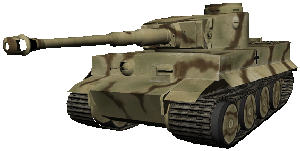 |

|
 |

|

Squads:
Feldjager
Das Bier Brigade
505th
1775th
1337th Scharfschutzin |

History of 1st Panzer Division
The 1st Panzer Division was formed October 15th, 1935 from the 3rd Cavalry Division, and was headquartered in Weimar. Initially it consisted of two panzer regiments organized into brigades, a motorized infantry brigade, a reconnaissance battalion, a divisional artillery regiment, and supporting ancillary formations.
In 1938 the division participated in training exercises with the XVI Corps, a fully motorized formation. By the start of the Polish Campaign in September 1939, the 1st Panzer Division was one of six panzer divisions in the Wehrmacht. It was deployed with the XVI Corps, Tenth Army, Army Group South, in the upper Silesia region.
XVI Corps, with the 1st and 4th Panzer Divisions, drove northeast into Poland, rapidly penetrating toward Warsaw. Between September 16th-20th they eliminated a Polish counter-attack along the river Bzura. With the double-encirclement of the Polish Army by the panzer divisions, resistance soon came to an end.
In May of 1940 the 1st Panzer Division joined Guderian's XIX Corps for the advance into France through the Ardennes forest. The corps achieved a decisive breakthrough at Sedan and by May 16th the panzer formations were advancing rapidly toward the English Channel coast. First Panzer Division came within 15 miles of Dunkirk despite determined British resistance, but was ordered to stop by the Fuehrer.
First Panzer Division was next deployed as part of XXXIX Corps on the Aisne River line for the advance south against the remaining French forces. Breakthrough was achieved by June 12th and the division advanced rapidly toward Belfort. An armistice with France was accepted on June 22nd, ending the campaign.
In October the 1st Panzer Division was reorganized as part of the Wehrmacht's increase in the number of mechanized divisions. The 2nd Panzer Regiment and selected cadres were removed for the formation of the 16th Panzer Division. In compensation, the 113th Panzergrenadier Regiment was added to balance the divisional organization.
Operation Barbarossa was the plan for the German invasion of the Soviet Union in June 1941. The 1st Panzer fought in Army Group North as part of the XLI Panzer Corps, advancing northward through Estonia. By July 14th the corps had reached the Luga River, only 70 miles from Leningrad. Here the corps waited for three weeks because Army Group North's flanks had become too extended.
With the army now at Lake Ladoga and the city of Leningrad cut off, 1st Panzer Division formed part of the general attack against the city perimeter on September 8th. The attack was making good progress and the corps advanced to within sight of the city. However the corps, including 1st Panzer Division, was ordered removed from the line on September 18th.
On October 2nd 1st Panzer Division joined the drive toward Moscow (Operation Typhoon) under XXXXI.Armeekorps (Mot.), assigned to Panzergruppe 3. The division achieved the closest approach to Moscow among the German forces, reaching Belyi-Rast at the end of November, only 25 miles from the Russian capital.
For the next two months 1st Panzer was on the defensive with the remainder of the German Army against the Russian winter offensive. It was defending Klin, to the northwest of Moscow, on December 7th. In January and February of 1942, the division fought against the Soviet Rzhev-Vyazma Offensive, some 100 miles west of Moscow. The division remained in the Rzhev area through the end of the year, before being withdrawn to France for refitting in January-February, 1943.
In June of 1943 the division was deployed to the Balkans region, then to Greece for coastal defense duties. It remained there until October, then returned to the Eastern front in November, where it participated in the defense of the Ukraine. The division did not attack as part of Battle of Kursk, but it fought in the desperate defense against the Russian advance west of Kiev.
During early 1943 the division was attached to III Panzer Corps and took its place in the relief of the Korsun-Cherkassy Pocket. In April 1944, as a part of Generaloberst Hans-Valentin Hube's First Panzer Army, the division was trapped in the Kamenez-Podolsky Pocket and was involved in the breakout.
In September 1944 the division was withdrawn to the Carpathian Mountains, as the Germans strove in vain to stem the Russian advance. By October the division was in Hungary, and in January, 1945 it fought in Operation Konrad, the abortive attempt to relieve the encircled city of Budapest.
Following the general German retreat to the west, the division finally reached the eastern Austrian alps where they surrendered to the US Army.
|
|
|
|
|
|
| |